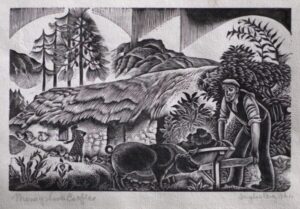Bliss, Douglas Percy (1900-1984)
Douglas Percy Bliss's family was originally from Northamptonshire but his grandfather moved to Morayshire in Scotland, where he raised a family of sixteen children. The future artist was born in Karachi, India (now Pakistan). Douglas always regarded himself as Scottish, as he was raised in Edinburgh and was educated at George Watson's College 1906-17. On leaving school, he joined the Highland Light Infantry until the end of the Great War in 1918. He went on to gain an M.A. honours degree in English Lit. at Edinburgh University 1922. The study of Art History in his first year encouraged his lifelong interest in art and architecture. After obtaining his degree, D.P. Bliss studied painting at the Royal College of Art in London. He became student editor of the R.C.A. magazine. Impressed by the imaginative quality of his third magazine, in which he introduced the innovation of hand- colouring by stencil, the British Museum bought several copies and which sent one to the Louvre Print Room in Paris. He discovered an ideal medium for his artistic and design talents when he studied wood engraving in his post-graduate year. The high quality of Bliss's engravings was quickly admired beyond the walls of the R.C.A.
In 1925, the august and supremely conservative Oxford University Press published a book of engravings by the young art student illustrating 'Border Ballads'. Commissions quickly followed on the success of 'Border Ballads', including illustrations for 'The History of Rasselas' by Dr. Johnson, published by J.M. Dent in 1926. The same publishers paid a great compliment to Bliss when they commissioned him to write 'A History Of Wood Engraving'. Even today this is regarded as one of the best expositions ever written about this specialised field of Art. Good copies of the 1928 edition are eagerly sought by dealers and students in Europe and America.
Early in his career, Bliss stated he wanted to 'draw trees really well'. In a variety of media, he used his characteristic muted colours and the clean lines of an engraver to celebrate the English and Scottish Landscapes. Sadly, much of the work of his talented youth was lost. When war broke out in 1939, his collection of engraved blocks was still mostly unpublished. During the Blitz, the entire collection was stolen from his London home. However, almost forty years after the theft, sixteen of the missing blocks were identified at an auction in Somerset. They had not been properly cared for and the bigger ones split when printing was attempted. Thus good prints of his wood engravings, perhaps the most characteristic expression of his Art, are rare.
Showing all 2 resultsSorted by latest

